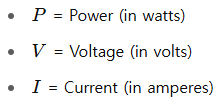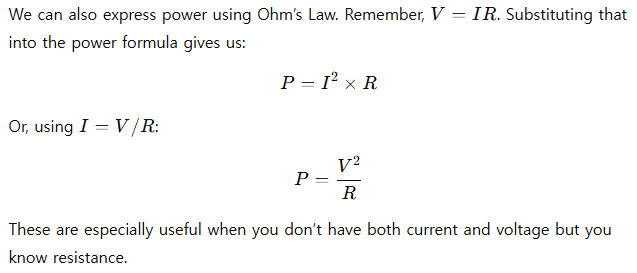Power and Energy in Circuits: Explained in Simple Words
If you’ve been studying Ohm’s Law, KVL, and KCL, it’s time to move on to something just as important—electric power and energy. These aren’t just textbook terms. Power tells us how fast energy is being used or delivered in a circuit. And energy? It tells us how much total “effort” was spent over time.
Let’s break it down in a way that actually makes sense, with some formulas, clear examples, and everyday analogies.
💡 What Is Electric Power?
Power is the rate at which electrical energy is transferred in a circuit. Think of it like water flowing through a pipe—power is how much water is flowing per second, not just how much water there is.
The most common formula for electric power is:

Where:

Let’s say a resistor has 5 volts across it and 2 amps flowing through. The power being used is:

So, the resistor is consuming 10 watts of power. Simple, right?
🔄 Variations of the Power Formula

These are especially useful when you don’t have both current and voltage but you know resistance.
⚡ What Is Energy in Electrical Circuits?
If power is the rate, then energy is the total amount used or delivered over time. Think of it as the “total electricity bill” rather than how fast you’re using energy right now.
The formula for electrical energy is:

Where:

For example, a 100W bulb running for 60 seconds:

That’s 6000 joules of energy spent to keep that bulb on for one minute.
🧠 Why Does Energy Conservation Matter?
Here’s the kicker: energy is always conserved. That means energy can’t just vanish or appear out of nowhere. It only transforms—from electrical energy into heat, light, motion, etc.
In a closed system:

So, when a battery powers a motor, the electrical energy is converted into motion (mechanical energy), with some heat lost along the way.
✅ Example 1: Power and Energy in a Resistor
Problem: A 10Ω resistor has 3A flowing through it for 2 minutes. Find the power and total energy consumed.
Step 1: Calculate Power

Step 2: Convert time to seconds

Step 3: Calculate Energy

So the resistor consumes 10800 joules of energy in two minutes.
✅ Example 2: Energy Use in a Light Bulb
Problem: A 60W light bulb runs for 5 hours. How much energy does it use in kilowatt-hours?
Step 1: Convert time to hours
Already given: 5 hours
Step 2: Use energy formula

So, it uses 0.3 kilowatt-hours of energy. That’s the unit your electric company charges you for.
📚 Tips to Remember
- Power is instantaneous; energy is accumulated.
- Watch your units:
- Use seconds with joules
- Use hours with kilowatt-hours
- Always match voltage and current directions correctly to avoid sign errors.
💬 Real-World Connection
When you look at your electricity bill, it’s measured in kilowatt-hours (kWh), not watts. That’s because you’re being charged for how much energy you used—not just how fast you used it.
One 1000W heater running for 1 hour = 1 kWh = you get charged!
🔚 Wrapping It Up
Power and energy are two of the most practical, real-life electrical concepts you’ll encounter. They apply whether you’re working on a microcontroller circuit or designing a building’s lighting system. Understanding how to calculate them and apply the law of conservation of energy isn’t just academic—it’s foundational.
With a few formulas, some solid intuition, and examples like the ones above, you’re now more equipped to tackle circuit analysis with confidence.

Leave a Reply